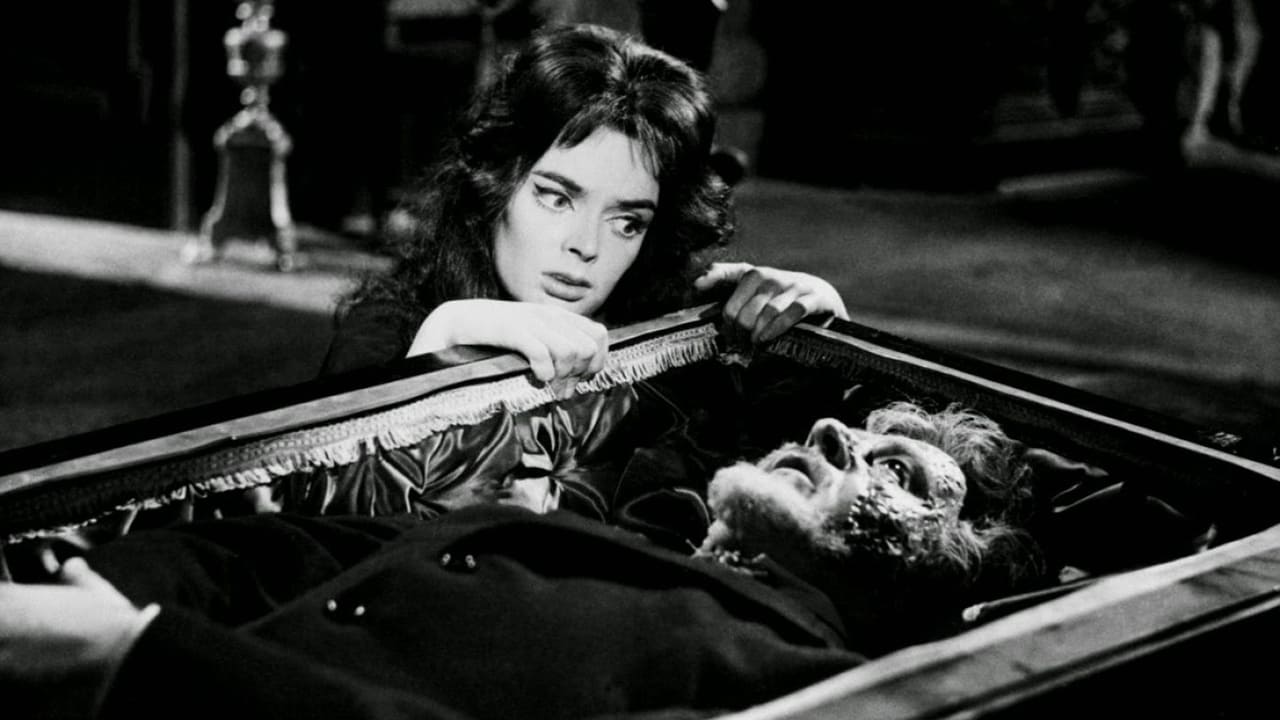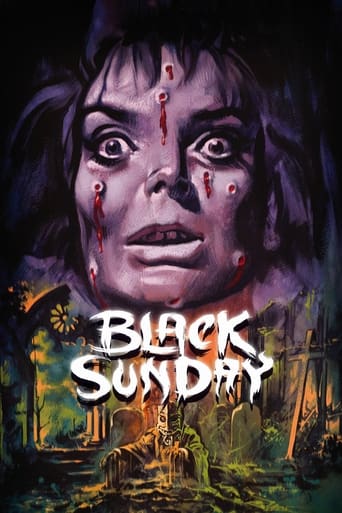Solidrariol
Am I Missing Something?
Beystiman
It's fun, it's light, [but] it has a hard time when its tries to get heavy.
Breakinger
A Brilliant Conflict
Salubfoto
It's an amazing and heartbreaking story.
jadavix
"Black Sunday", also known as "The Mask of Satan", is considered to be Italian horror maestro Mario Bava's directorial debut, after he did uncredited work on a few prior movies. It is also the film that launched his career on the international stage.It is not surprising to discover that Bava had been a cinematographer for almost twenty years before he directed "Black Sunday". Simply put, the movie looks beautiful. The photography is exquisite, and the framing of each shot perfectly uses the film's quintessentially Gothic scenery.The movie is, basically, like looking at a book of Gothic photography come to life.This also has the correlative of making the movie's plot and characters distant and uninvolving.Beautiful photography is by its nature distancing. It makes you aware of the beauty of its subject, certainly, but also in so doing, makes you aware of its distance from you, thumbing through the book in your living room or book shop as you probably are.Cinema, with its marriage of the moving image with sound, can dissolve that barrier."Black Sunday", unfortunately, fails to do this. The story is something to do with an evil witch-vampire played by the brick-jawed Barbara Steel. She does have a very memorable introduction as we see her killed in one of horror's most memorable death sequences: a mask with nails on the inside is nailed onto her face, blood gushing from underneath it.Two hundred years later (in 1830 or thereabouts) some men stumble onto the tomb of the witch, and cutting his hand, one of the guys accidentally wakes her up. He also meets a descendant of the witch - also played by Barbara Steel in a double-role - and is struck by her beauty. Of course, the vampire-witch wants revenge on the descendants of those who had her executed, and commands her brother-in-arms to rise from his grave and start killing.I found it impossible to care about this movie beyond its beautiful looks. Part of the problem is Steel; with a double role, she doesn't make enough of an impression as either of the characters she plays. You will not be surprised to read that she did not get along with Bava on the set of this movie. Her performance seems reluctant, like the guy behind the camera wants her to show something she didn't sign on for.Another problem is that the movie is unnecessarily confusing toward the end. I admit I lost track of exactly what was going on.It seems as though Bava devoted all his energy to the filming of locations and objects, without bothering to get us close to the story or characters. Perhaps the defiant and brick-jawed Barbara Steel put him off?
trishaade
"Black Sunday" is one of my all time favorite horror movies - definitely in my top 10. Considered to be a cult classic, it undeniably deserves that honor. The story concerns a witch/vampire who is executed (quite the nasty little scene for the '60s) who vows revenge on the descendants of her persecutors. Due to a mishap, she gets the opportunity to do just that 200 years later and goes after folks with a vengeance, especially her descendant Katia.This film was my introduction to Barbara Steele who plays duel roles as both the vampire/witch and her contemporary counterpart. The fact that she is able to play two characters - one embodying evil, the other innocence - and play them both very well gives you an idea of her range. One of the things I've loved about her from the very beginning is that she uses her whole body to express herself in the parts that she plays. It is quite effective. One thing to keep in mind if you haven't seen it is that the film was originally done in Italian, so the English version is dubbed. For me personally, I was so mesmerized that I really didn't notice. It was also shot in black and white and made in 1960, so you are not going to see the over the top special effects and the fast pace that are so common in horror these days. For the time it was made, I thought the little gore the movie has, the effects and the makeup were quite well done.From what I understand, "Black Sunday* was banned in Great Britain for a while and some versions of it are censored - I apparently had the good luck to see a mostly uncensored version (without the "special" relationship between Asa and her brother). Try to find one of those if you can.The film slows down just a bit in the middle as the family and some folks in town realize something is amiss. Even so, it is truly worth the watch. It is unbelievably eerie and beautifully shot - if nothing else, it should be seen for those reasons alone. Is this movie going to keep you up at night or make you keep your lights on for a couple days? Probably not if you are watching current horror. It is, however, an excellent movie for it's time and unquestionably a must see for fans of classic Gothic horror. I absolutely loved it.
CinemaClown
A tad too graphic for its time, Mario Bava's Black Sunday is an incessantly Gothic, chilling & eerie example of horror filmmaking that is now counted amongst the greatest examples of its genre, and although it was deemed too extreme for the filmgoing audience during its time of release, its lasting influence on horror cinema cannot be downplayed.The story of Black Sunday concerns a witch who was condemned to death for sorcery by her very own brother but, in her final words, vows revenge and puts a curse on him & his descendants. Her resurrection is triggered when two doctors inadvertently awaken her two centuries later, following which she attempts to possess the body of a lookalike descendant.Directed by Mario Bava in what's his directional debut, Black Sunday remains his most revered film to date and despite being over half a century older, it is still capable of startling a few viewers. The prologue alone contains imagery that's gonna evoke visceral reaction from its audience, and Bava's direction is commendable, for this Gothic chiller is crafted with passion.Shot in black-n-white, the images are sharp, crisp & finely detailed. Camera-work is expertly carried out with Bava making use of different styles & techniques to amplify the effect of a given segment. The Gothic vibe is consistently maintained and its 87 minutes runtime is splendidly paced but there were a few moments that felt unnecessary plus its background score isn't seamless either.Coming to the performances, the cast comprises of Barbara Steele, John Richardson, Ivo Garrani & Arturo Dominici, with Steele impressing the most. Playing both the witch & the descendant, Steele pretty much nails it in the role of the former while as latter, there are few instances when she goes overboard, possibly because her character is written that way. Nevertheless, she is well supported by the rest of the cast.On an overall scale, Black Sunday is a masterwork of expressionist horror that's not just notable for launching the careers of Bava & Steele but is also notorious for pushing the boundaries of what's acceptable on the film screen. Technically accomplished & narratively engaging, Mario Bava's labour of love retains much of its potency after all these years, and the aura of its meticulously constructed sets are so rich & dense that it will keep the viewers hexed throughout its runtime. Highly recommended.
BA_Harrison
When Dr. Thomas Kruvajan (Andrea Checchi) is attacked by a giant rubber bat while exploring an old crypt with his assistant Dr. Andre Gorobec (John Richardson), he accidentally smashes the stone cross positioned over the coffin of vampiric witch Asa Vajda (Barbara Steele); to make matters worse, he removes the mask covering her face, cutting himself in the process (silly old doctor). With the cross destroyed, the mask gone, and the doctor's blood dripping into the coffin, Asa is resurrected, and, with the help of fellow vamp Javuto (Arturo Dominici), she wreaks revenge on the ancestors of those who sentenced her to death.The opening scene to Mario Bava's Black Sunday AKA The Mask of Satan delivers one of the most potent images in the history of Italian horror cinema: a spiked, metal devil mask being hammered onto the face of vampiric witch Asa Vajda (squelch!). Unfortunately, so shocking and brutal is this scene that, as impressive as Bava's beautiful black and white cinematography is throughout the rest of his film, there is nothing to rival Asa's brutal execution in terms of sheer horror, making everything that follows something of a let-down.This feeling of disappointment isn't helped by the hoary old Gothic horror nonsense that unfolds, which is loaded with tired genre clichés (creaky old doors, stormy weather, cobweb covered tombs, hidden passageways, villagers armed with pitchforks and torches) and which suffers from a script packed with verbose dialogue that is frequently laughable (example: "What is my life? Sadness and grief. Something that destroys itself day by day and no-one can rebuild it. Here is the very image of my life. Look at it… it is being consumed hour by hour like this garden, abandoned to a purposeless existence."). Inspired use of light and shadow and acute visual lyricism can only excuse so much.

